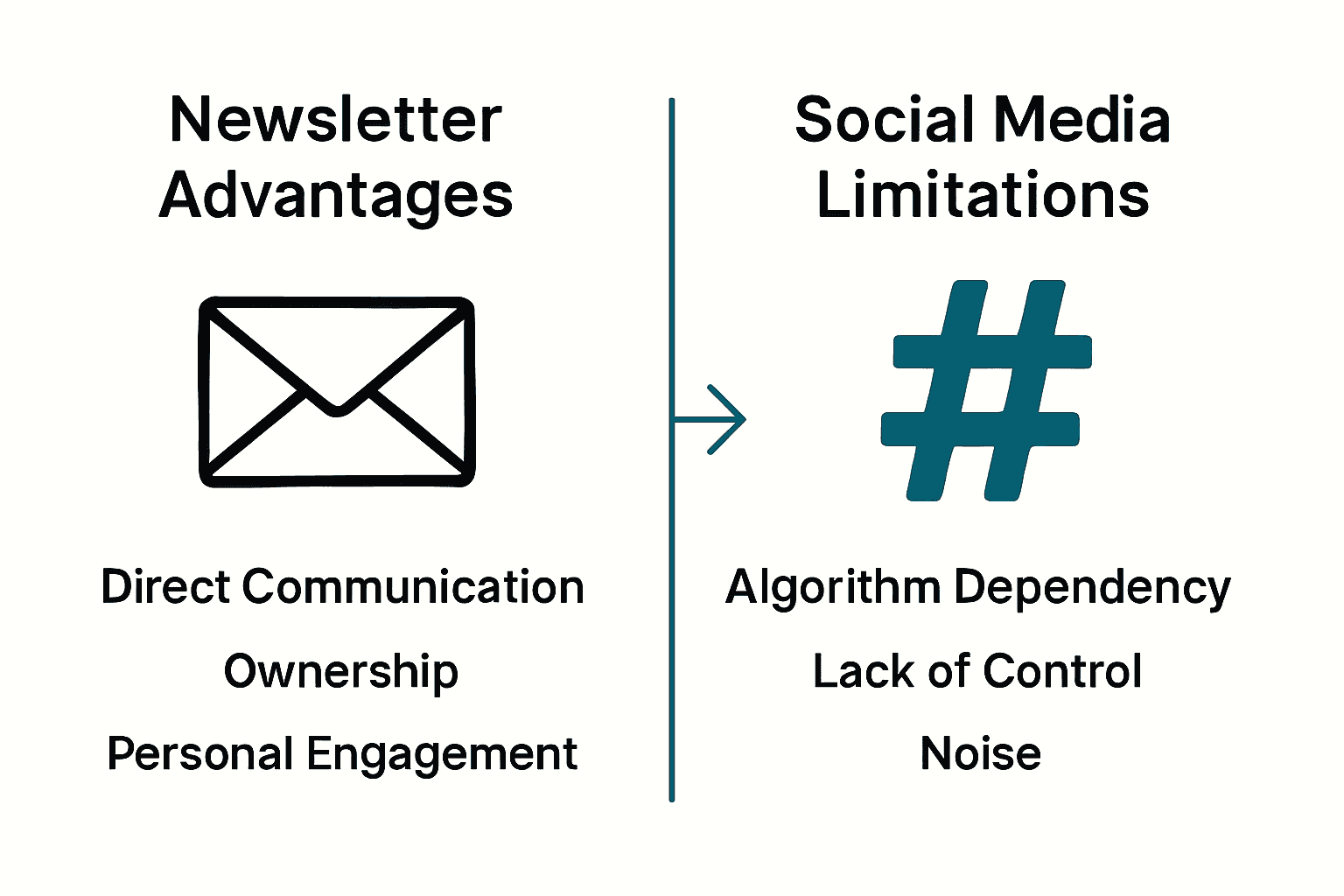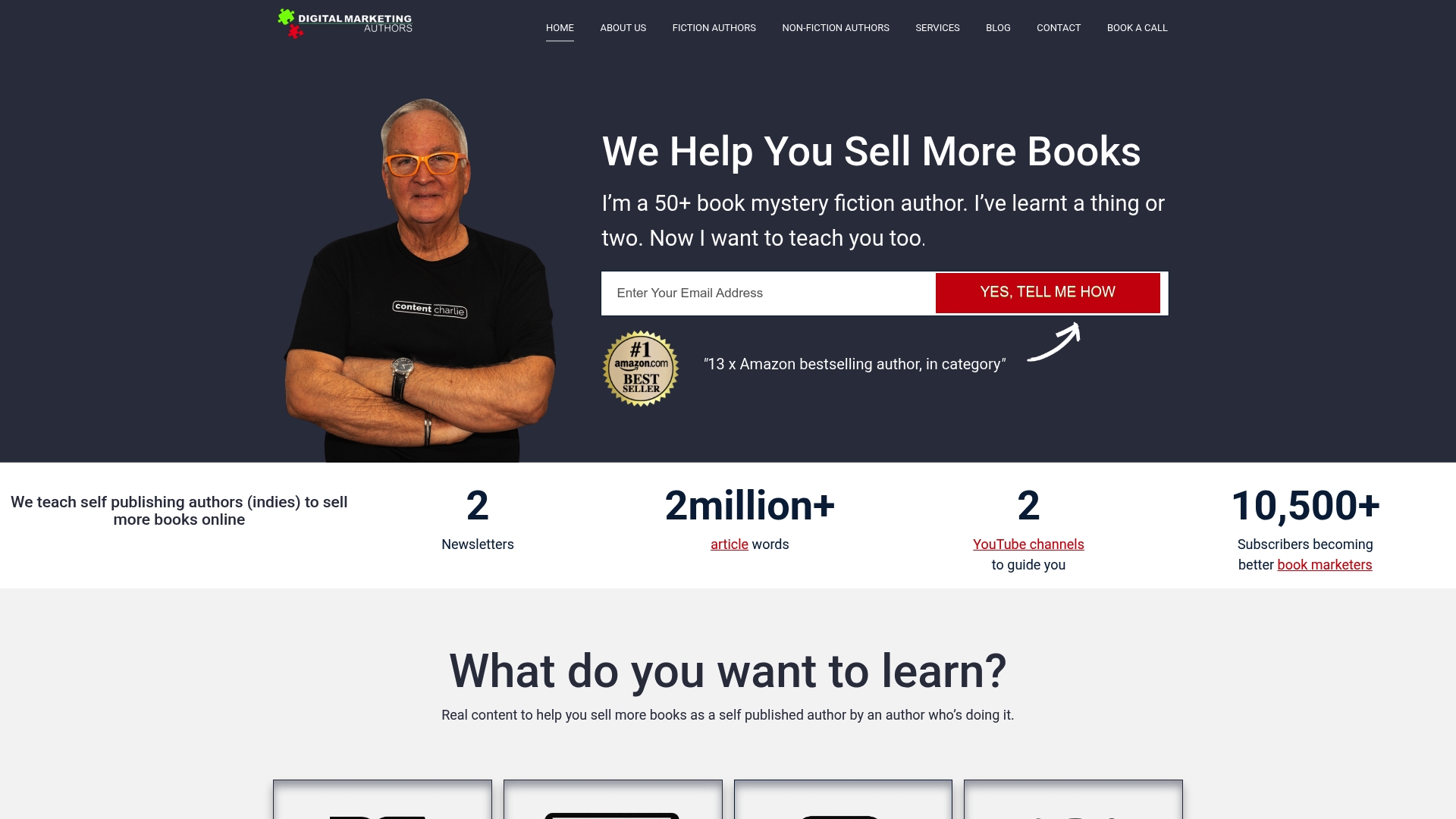- You are here:
- Home »
- Newsletters
Category Archives for Newsletters

Role of Newsletters for Writers: Complete Guide
More than 80 percent of writers say email newsletters are their top way to connect with readers. As inboxes become the new front row for creative voices, newsletters offer something social media cannot: direct, personal communication that cuts through the noise. Writers are finding fresh ways to build devoted audiences, share exclusive content, and shape their brand—all while staying in control of their message.
Key Takeaways
| Point | Details |
|---|---|
| Direct Communication | Newsletters enable authors to reach their audience directly, enhancing personal engagement and brand loyalty. |
| Community Building | Newsletters foster interactive relationships, transforming readers into active community members through consistent, authentic communication. |
| Monetization Opportunities | Authors can leverage newsletters for income through various strategies such as paid subscriptions, sponsorships, and affiliate marketing. |
| Avoid Common Mistakes | Effective newsletters require compelling subject lines, consistent scheduling, and clear calls to action to maintain reader interest and engagement. |
Table of Contents
- Defining Newsletters For Writers Today
- Types Of Author Newsletters And Differences
- How Newsletters Build Reader Communities
- Monetization Strategies For Indie Authors
- Common Newsletter Mistakes To Avoid
Defining Newsletters for Writers Today
A newsletter represents a powerful communication tool that allows writers to connect directly with their audience through regular, curated content delivered straight to readers’ email inboxes. According to Wikipedia, a newsletter is a printed or electronic report sent to subscribers containing topics of interest, with e-newsletters becoming increasingly popular among professional writers seeking to maintain consistent engagement.
For modern authors, newsletters serve multiple strategic purposes beyond simple communication. They function as a dynamic platform for writers to:
- Build a loyal reader community
- Share exclusive behind-the-scenes insights
- Promote upcoming book releases
- Cultivate direct relationships with fans
- Establish personal brand authority
As research from Convert Now indicates, author newsletters fundamentally allow writers to take control of their audience by reaching them directly via email. This direct line of communication enables writers to enhance their brand through personal style and insights while systematically cultivating reader loyalty.
Unlike social media platforms where algorithms determine content visibility, newsletters provide writers complete ownership of their communication channel. Writers can craft personalized, targeted content that resonates deeply with their specific reader base, transforming casual readers into dedicated fans who eagerly anticipate each new publication.

Types of Author Newsletters and Differences
Author newsletters are not a one-size-fits-all communication strategy. According to research from Beehiiv, writers can craft newsletters in multiple distinct formats, each serving unique audience engagement goals. Understanding these variations allows authors to select the most effective approach for their specific writing genre and reader preferences.
The primary newsletter types for authors include:
Here’s a comparison of the main types of author newsletters:
| Newsletter Type | Main Focus | Best For |
|---|---|---|
| Curated | Links & Resources | Resource-hunting readers |
| Practical | How-to Tips & Techniques | Writers seeking actionable advice |
| Personality-Driven | Author’s Stories & Journey | Readers wanting personal insights |
| Analytical | Expert Analysis & Industry | Non-fiction or thought leaders |
| Inspirational | Quotes & Motivation | Writers needing encouragement |
- Curated Newsletters: Collections of carefully selected links, summaries, and recommended resources
- Practical Newsletters: Actionable how-to content and writing technique insights
- Personality-Driven Newsletters: Personal storytelling showcasing the author’s journey and worldview
- Analytical Newsletters: In-depth, long-form expert analysis and industry perspectives
- Inspirational Newsletters: Quote compilations and motivational content for writers
Research from Feather further elaborates on newsletter formats, highlighting that successful newsletters can range from weekly industry news digests to personal recommendation platforms. Each format offers distinct advantages: curated links provide quick value, tool roundups offer practical resources, and personal reflection newsletters build deeper reader connections.
The key is matching your newsletter style to your writing goals and audience expectations. A fiction author might leverage personality-driven newsletters to share character development insights, while a non-fiction writer could use analytical formats to demonstrate industry expertise. Your newsletter becomes an extension of your writing voice – a powerful tool for building a loyal, engaged readership.

How Newsletters Build Reader Communities
Community building through newsletters transforms passive readers into active, engaged participants in an author’s creative ecosystem. Modern digital platforms have revolutionized how writers connect with their audience, moving beyond traditional one-way communication models to create interactive, meaningful relationships.
According to research on community-building tools, platforms like Substack and Beehiiv now offer sophisticated features that enable authors to cultivate vibrant reader communities. These tools provide critical engagement mechanisms such as:
- Direct comment sections
- Integrated chat functionalities
- Referral program incentives
- Interactive discussion spaces
- Personalized reader feedback channels
Newsletters create a unique intimacy that social media cannot replicate. By delivering content directly to a reader’s inbox, authors establish a personal connection that feels more deliberate and meaningful. Readers aren’t just consuming content; they’re becoming part of an exclusive community that shares common interests, values, and literary passions.
The magic of newsletter community building lies in consistency, authenticity, and interaction. Successful authors use their newsletters not just as broadcast tools, but as conversation starters. They share personal stories, solicit reader opinions, offer behind-the-scenes glimpses into their writing process, and create a sense of belonging. This approach transforms readers from distant consumers into invested community members who feel personally connected to the author’s journey and creative vision.
Monetization Strategies for Indie Authors
Newsletter monetization represents a transformative opportunity for independent authors to generate direct revenue from their writing and audience relationships. According to research on Substack, modern digital platforms now provide sophisticated infrastructure that enables writers to earn income directly from subscriber contributions.
Independent authors can explore multiple monetization approaches:
- Paid Subscription Tiers: Offering exclusive content at different price points
- Sponsorship Opportunities: Partnering with brands relevant to your audience
- Premium Content Sections: Gating advanced or in-depth material
- Affiliate Marketing: Recommending products with commission structures
- Digital Product Sales: Selling workshops, guides, or exclusive resources
The most powerful monetization strategy involves creating genuine value that readers are willing to pay for. This means developing high-quality, unique content that readers cannot easily find elsewhere. Successful authors understand that monetization isn’t about extracting money, but about providing exceptional insights, entertainment, or expertise that readers perceive as worth their investment.
Newsletters offer unparalleled advantages over traditional publishing models by providing direct financial connections between authors and readers. By cultivating a loyal audience and consistently delivering compelling content, indie authors can transform their newsletters from communication tools into sustainable revenue streams. The key is maintaining authenticity, understanding your audience’s needs, and continuously evolving your offering to provide exceptional value.
Common Newsletter Mistakes to Avoid
Newsletter failures often stem from overlooking critical design and communication principles that separate engaging content from forgettable emails. According to research from Letterbucket, authors frequently stumble into predictable traps that can dramatically reduce reader engagement and newsletter effectiveness.
The most prevalent newsletter mistakes include:
- Weak Subject Lines: Failing to create compelling, curiosity-driving headlines
- Irregular Scheduling: Inconsistent publication times that confuse readers
- Lack of Audience Segmentation: Treating all subscribers as a monolithic group
- Excessive Self-Promotion: Overwhelming readers with constant sales pitches
- Poor Design and Mobile Optimization: Unreadable layouts across devices
- Missing Clear Calls to Action: Leaving readers uncertain about next steps
- Ignoring Performance Metrics: Not analyzing what content truly resonates
Research from Kasplo further highlights the importance of personalization and tone. Successful newsletters avoid robotic, impersonal language and instead create a conversational, authentic connection. The key is balancing professional insights with a genuine, approachable writing style that makes readers feel like they’re receiving a personal communication from a trusted friend.
Ultimately, avoiding these common pitfalls requires thoughtful, strategic approach to newsletter creation. Authors must view their newsletter as a relationship-building tool, not just a broadcasting channel. By prioritizing reader experience, consistently delivering value, and remaining adaptable to audience feedback, writers can transform potential mistakes into opportunities for deeper reader engagement.
Turn Your Newsletter Into a Profitable Reader Magnet
Are you finding it difficult to build real connections and sell more books despite your best efforts with newsletters? Many writers struggle with inconsistent engagement, weak community building, and newsletters that just do not translate to real results. The article highlights the importance of audience ownership, clear calls to action, and engaging content. But the path from recognizing these issues to launching a loyal, buying reader base often feels overwhelming.

You do not have to figure this out alone. At Digital Marketing Authors, you will discover step-by-step systems that take your newsletter from forgettable to unmissable. We show you how to automate your author brand, grow devoted reader communities, and turn every email into a revenue opportunity. If you are ready to stop guessing and start building your own profitable audience, visit Digital Marketing Authors and take your writing career to the next level now.
Frequently Asked Questions
What is the purpose of a newsletter for writers?
A newsletter allows writers to communicate directly with their audience, sharing curated content, insights, book promotions, and fostering a loyal reader community.
What types of newsletters can authors create?
Authors can create various types of newsletters, including curated, practical, personality-driven, analytical, and inspirational, each serving unique engagement goals.
How can newsletters help build a reader community?
Newsletters facilitate community building by transforming passive readers into engaged participants, creating a personal connection through direct communication and fostering interaction and feedback among subscribers.
What are effective monetization strategies for indie authors using newsletters?
Indie authors can monetize their newsletters through paid subscription tiers, sponsorship opportunities, premium content sections, affiliate marketing, and digital product sales, focusing on providing unique value to their audience.
Recommended
- author newsletter Archives – DigitalMarketingAuthors.com
- Author Newsletter Archives – DigitalMarketingAuthors.com
- publish an author newsletter Archives – DigitalMarketingAuthors.com
- author newsletter publishing Archives – DigitalMarketingAuthors.com
